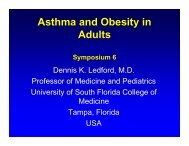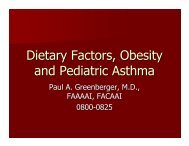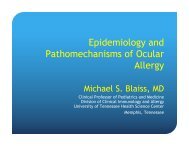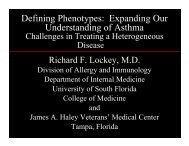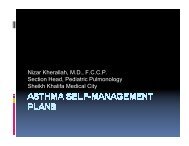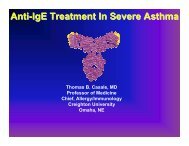Dubai Final-v20.indd - World Allergy Organization
Dubai Final-v20.indd - World Allergy Organization
Dubai Final-v20.indd - World Allergy Organization
Create successful ePaper yourself
Turn your PDF publications into a flip-book with our unique Google optimized e-Paper software.
ABstrACts<br />
ABstrACts<br />
cases were positive for hmPV. HmVP prevalence among male was three times greater than female. All of the positive hmPV children<br />
were affected by wheezing. more over 31.3% were simultaneously affected by wheezing and asthma. significant correlation<br />
between clinical manifestation and more than 2 days of hospitalization and positivity of hmPV were detected.<br />
Conclusion: HmPV prevalence in children with asthma and wheezing was almost the same in shiraz in compare with the other part<br />
of the world. recent findindgs suggest a probable role of hmPV in asthma exacerbation and wheezing onset.<br />
3112<br />
SEroPrEValEnCE oF aniSaKiaSiS analiSYS rESiDEnTS From “alDEa DE PESCaDorES” ToWn, PUErTo la CrUZ,<br />
anZoaTEgUi 2010<br />
naime, m. , sofia, m. and Elizabeth, P.<br />
Escuela De Ciencias De la salud, Universidad de oriente, Puerto la Cruz, Venezuela.<br />
Anisakiosis is a zoonosis caused by nematodes Anisakidae family, of which there are many genres distinguished by their public<br />
health concern as: Pseudoterranova, Contracaecum, Hysterothylacium and Anisakis. Furthermore, there are four species recognized<br />
from Anisakis: A. simplex, A. physeris, A. typical and A. schupakovi. Anisakis simplex is being the most studied parasite in clinical<br />
practice, parasitizing marine mammals in its adult form, and in different larval stages affects fish and cephalopods. the humans,<br />
being an accidental host, it is acquired through the consumption of raw or undercooked fish. Anisakiosis could be a public health<br />
problem, especially in areas where the economy and feeding depend on fishing, causing health problems for the whole community.<br />
objectives: analyze the seroprevalence of anisakiasis in residents from “Aldea de Pescadores” town, sector i, Puerto la Cruz,<br />
Anzoátegui state. materials and methods: it was conducted an exploratory, field, prospective, cross-sectional research. there<br />
were taken samples of 93 local people from “Aldea de Pescadores” which were tested by Prick test and specific igE determination<br />
in order to detect positive Anisakiosis cases, to carried out a hypothesis test, analyzed by sPss 17.0. results: there was a (8.6%)<br />
of positive prick test to Anisakis simplex; 6.5% for the specific igE determination to the same parasite. However, verified the null<br />
hypothesis there were no differences in the prevalence of gastrointestinal, dermatological and/or breathing symptoms in those with<br />
skin and serological positive tests for Anisakis simplex. Conclusions: the results indicate that the Anisakis simplex infection is not<br />
a public health problem in “Aldea de Pescadores” town. nevertheless, there are a positive percentage of Anisakiasis cases in this<br />
town. For this reason, it is necessary the spread of information, and the application of prophylactic measures to avoid the increasing<br />
number of people affected by this disease.<br />
Keywords: Anisakiasis, Prick test, igE, Anisakis simplex.<br />
3113<br />
EFFECTS oF VarioUS rESPiraTorY VirUSES on DEr F-SEnSiTiZED moUSE moDEl oF aSTHma<br />
Kim, H. H. , Chun, Y. H. , Yoon, J. , Kim, J. t. and lee, J. s.<br />
Pediatrics, the Catholic University of Korea, Pucheon-si, south Korea.<br />
Purpose: respiratory viral infection is the main cause of acute asthma exacerbation in children and can be a confirmed viral<br />
infection in 85% of children who visit a hospital because of asthma exacerbation. Viruses related to acute asthma exacerbation are<br />
rhinovirus (rV), respiratory syncytial virus (rsV), parainfluenza virus (PiV), human metapneumovirus (hmPV) and influenza virus.<br />
Among the viruses, rV is the most well-known frequent cause virus of acute asthma exacerbation for children 2 years or more.<br />
some in vitro studies showed the immunologic responses after rV infection were different from other respiratory viruses. this<br />
may refer that the response to rV infection can be different to other respiratory viruses in patients with asthma. in this experiment,<br />
we determined cell counts and the level of cytokines in bronchoalveolar lavage fluid (BAlF) of asthma mouse model after being<br />
infected by rV, rsV, or influenza virus in order to evaluate that there are differences in the kind of virus.<br />
methods: Asthma mouse model is made by sensitizing BAlB/c mouse to house dust allergen Der f. the asthma mouse model is<br />
confirmed by measuring the airway resistance caused by methacholin inhalation, the eosinophil counts, interleukin (il)-4, il-5 and<br />
il-13 in BAlF, and by observing peribronchial eosinophilic inflammation of lung tissue through a microscope. After the prepared<br />
asthma mouse model is infected by rV, rsV, and the influenza virus respectively, the rt-PCr is used to confirm the existence of<br />
virus genes in lung tissue. We determined the number of eosinophils, neutrophils, lymphocytes and macrophages in BAlF and<br />
measured rAntEs and inF-γ in BAlF of the mice infected by the viruses.<br />
results in the case of the Der f-sensitized mouse model with rV infection, the airway resistance and eosinophil counts in BAlF<br />
increased, and inF-γ level did not increase by the virus. these findings were different from in the case of rsV or influenza virus<br />
infection.<br />
Conclusion: in the case of infecting a respiratory virus to the developed asthma mouse model with the sensitized house dust mite<br />
allergen, increased airway resistance and eosinophilic inflammation with no increase in th1 response were shown only with rV.<br />
these findings can be related to the phenomenon that rV is most frequently found to be the cause of acute asthma exacerbation.<br />
www.worldallergy.org 144<br />
FinAl PrOgrAm





